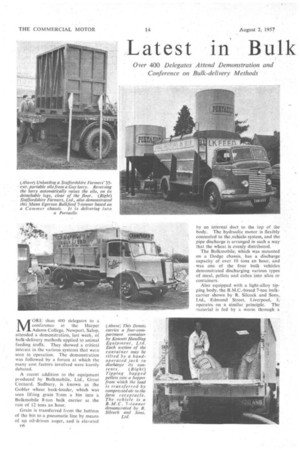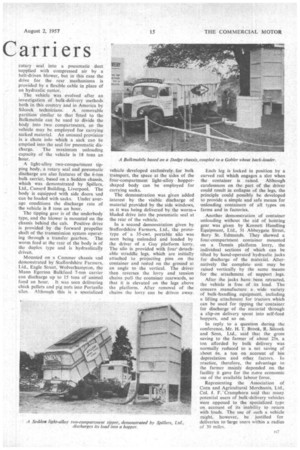Latest in Bulk Carriers
Page 46

Page 47

If you've noticed an error in this article please click here to report it so we can fix it.
Over 400 Delegates Attend Demonstration and Conference on Bulk-delivery Methods MORE than 400 delegates to a conference at the Harper Adams College. Newport, Salop, attended a demonstration, last week, of bulk-delivery methods applied to animal feeding stuffs. They showed a critical interest in the various system § that were seen in operation. The demonstration was followed by a forum at which the many cost factors involved were keenly debated.
A recent addition to the equipment produced by Bulkmobile, Ltd., Great Cornard, Sudbury, is known as the Gobler wheat back-loader, which was seen lifting grain from a bin into a Bulkmobile 8-ton hulk carrier at the rate of 12 tons an hour.
Grain is transferred from the bottom of the bin to a pneumatic line by means of an oil-driven auger, and is elevated by an internal duct to the top of the body. The hydraulic motor is flexibly connected to the ,vehiclo system, and the pipe discharge is arranged in such a way that the wheat is evenly distributed.
The Bulkmobile, which was mounted on a Dodge chassis, has a discharge capacity of over 10 tons an hour, and was one of the four bulk vehicles demonstrated discharging various types of meal, pellets and cubes into silos or containers.
Also equipped with a light-alloy tipping body, the B.M.C.-based 7-ton bulkcarrier Shown by R. Silcoek and Sons, Ltd., Edmund Street, Liverpool, 3, operates on a similar principle. The material is fed by a worm through a
rotary seal into a pneumatic duct supplied with compressed air by a belt-driven blower, but in this case the drive for the rear mechanisms is provided by a flexible cable in place of an hydraulic motor.
The vehicle was evolved after an investigation of bulk-delivery methods both in this country and in America by Silcock technicians. A removable partition similar to that fitted to the Bulk mobile can be used to divide the body into two compartments, so the vehicle may be employed for carrying sacked material. An unusual provision is a chute into which a sack can be emptied into the seal for pneumatic discharge. The maximum unloading capacity of the vehicle is 18 tons an hour.
A light-alloy two-compartment tipping body, a rotary seal and pneumatic discharge are also features of the 6-ton bulk carrier, based on a Seddon chassis, which was demonstrated by Spillers, Ltd., Cunard Building, Liverpool. The body is equipped with side doors and can be loaded with sacks. Under average conditions the discharge rate of the vehicle is 8 tons an hour.
The tipping gear is of the underbody type, and the blower is mounted on the chassis behind the cab. Positive drive is provided by the forward propeller shaft of the transmission system operating through a transfer gearbox. The worm feed at the rear of the body is of the duplex type and is hydraulically driven.
Mounted on a Commer chassis and demonstrated by Staffordshire Farmers, Ltd., Eagle Street, Wolverhampton, the Mann Egerton Bulkfeed 7-ton carrier can discharge up to 15 tons of animal food an hour. It was seen delivering chick pellets and pig nuts into Portasilo silos. Although this is a specialized vehicle developed exclusively for bulk transport, the space at the sides of the four-compartment light-alloy hoppershaped body can be employed for carrying sacks.
The demonstration was given added interest by the visible discharge of material provided by the side windows, as it was being delivered by the worm-. bladed drive into the pneumatic seal at the rear of the vehicle.
In a second demonstration given by Staffordshire Farmers, Ltd., the prototype of a 35-cwt. portable silo was seen being unloaded and loaded by the driver of a Guy platform lorry. The silo is provided with four detachable straddle legs, which are initially attached to projecting pins on the container and rested on the ground at an angle to the vertical. The driver then reverses the lorry and tension chains pull the container rearwards, so that it is elevated on the legs above the platform. After removal of the chains the lorry can be driven away. Each leg is locked in position by a curved rail which engages a slot when the container is raised. Although carelessness on the part of the driver could result in collapse of the legs, the principle could possibly be developed to provide a simple and safe means for unloading containers of all types on farms and in factories.
Another demonstration of container unloading without the aid of hoisting gear was given by Kennett Handling Equipment, Ltd., 31 Abbeyg:ate Street, Bury St. Edmunds. They showed a four-compartment container mounted on a Dennis platform lorry, the individual sections of which can be tilted by hand-operated hydraulic jacks for discharge of the material. Alternatively the completeunit may be raised vertically by the same means for the attachment of support legs.
After the jacks have been retracted, the vehicle is free of its load. The concern manufacture a wide variety of bulk-handling equipment, including a lifting attachment for tractors which can be used for tipping the container for discharge of the material through a clip-on delivery spout into self-feed hoppers, and so on.
In reply to a question during the conference, Mr. H. T. Brook, R. Silcock and Sons, Ltd., said that the gross saving to the farmer of about 25s. a ton afforded by bulk delivery was normally reduced to a net saving of about bs. a ton on account of bin depreciation and other factors. In practice, therefore,. the advantage to the farmer mainly depended on the facility it gave for the more economic use of the available labour force.
Representing the Association of Corn and Agricultural Merchants, Ltd, Col. I. F. Cramphorn said that many potential users of bulk-delivery vehicles were opposed to the specialized type on account of its inability to return with loads. The use of 6uch a vehicle might, however, be justified for deliveries to large users within a radius of 30 miles.








































































































